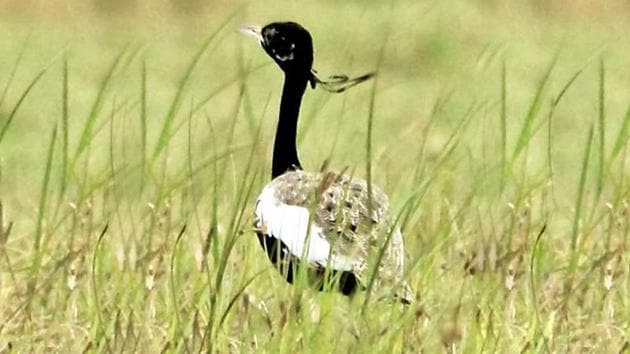With just 264 left in four states, Lesser Florican bird may go extinct: Report
There has been an 80% decline in the population of Lesser Florican since 2000 when around 3,500 birds were estimated to be in these four states, according to the report.
Once found in abundance, the Lesser Florican (sypheotides indicus), the smallest bustard , is in real danger of becoming extinct from the India with just 264 of them enumerated in the four states where they are usually found, down from 3,500 in 2000, according to a comprehensive survey of their main habitats by the forest departments of these states, a government run institute and two non-government organisations.

The bird is endemic to India.
Lesser Florican is one of the four bustard species of India, all of which are threatened under the International Union for the Conversation of Nature (IUCN) Red List of Threatened Species, the world’s biggest inventory of the conservation status of biological species.
Lesser Floricans are a bird watcher’s delight and during their mating season, which starts with the onset of the monsoon, the male acquires spectacular breeding plumage and jumps as high as two meters in the air, emitting a frog-like rattle which can be heard from 300-400 meters away, to attract the female.
Observations have shown that the male can jump 500-600 times a day during the height of the breeding season, said the report of the survey conducted between July-September 2017 by Dehradun based Wildlife Institute of India (WII) under its endangered species recovery programme along with Bombay Natural History Society (BHNS), Corbett Foundation and the forest departments of Madhya Pradesh, Gujarat, Maharashtra and Rajasthan.
The 120-page report published by WII on June 29 has estimated that going by a “conservative estimate” there are only 264 birds left in the country, an 80% decline in their population since 2000 when around 3,500 birds were estimated to be in these four states, which together account for more than 90% of Lesser Floricans in the country.
Even though the government has accorded the Lesser Florican the highest degree of protection by putting them under schedule-1 of the Wildlife Protection Act, 1972, their number has consistently declined.
Sutirtha Dutta, a research associate at WII associated with the survey, said the findings are alarming: “We consider a species to be in the critically endangered threshold if there is a 75% decline in the population within three generations, and this has happened in the case of the Lesser Florican. Immediate conservation methods are necessary to save the bird”.
The report submitted to the four states governments earlier this month lists loss of habitat and lack of comprehensive grassland policy as some of the main reasons for the depletion of their numbers.
According to IUCN, the bird, first recorded scientifically in 1782, was found in almost in every part of India from Gujarat till Bengal and from the Saharanpur and Mainpuri districts of Uttar Pradesh to Thiruvananthapuram . It also occurred in Terai region of Nepal, Pakistan, with vagrants being spotted even in Bangladesh and Myanmar.
Now, its home is limited to conservation reserves in four districts of western Rajasthan, five districts in Gujarat, four districts each in Madhya Pradesh and Maharashtra and one in Andhra Pradesh.
“Things are not so bad in Rajasthan and Gujarat,” Dutta said, while claiming that habitats in Madhya Pradesh and Maharashtra are in a very “bad” shape.
If unchecked, the Lesser Florican could go the way of the Great Indian Bustard, which almost became India’s national bird, and of which less than 100 are still alive.
The report said, these shy birds live in grasslands and eat insects and seeds, but over the years grasslands have been converted into agriculture land and use of chemical fertilizers have killed off the insects. Other reasons cited include poaching, free ranging dogs, windmills and excessive livestock grazing.
The measures to protected the few remaining homes of these birds listed by the report are scientific management of grasslands, local community participation in conservation, florican-friendly agriculture which includes less use of fertilizers, better conservation and monitoring and also a captive breeding programme.
Reacting to the observations in the report, chief wildlife conservator of forest (CCF) Ujjain, B S Annigeri, said : “We will draw up a plan this year based on the recommendation. Additional surveys will also be done.” The Sailana bird sanctuary in Ratlam district, which was specially created for the Lesser Florican, falls in the Ujjain forest division.
A Rajasthan forest department official said the department is working with a WII team to implement measures to protect bustard habitats that includes shifting of the windmills in the western part of the state. “We are setting up a breeding centre for all species of Great Indian Bustard in Kota shortly,” the official said, asking not to be identified.
Get Current Updates on Election 2024, India News, Lok Sabha Election 2024 LIVE along with Latest News and Top Headlines from India and around the world.




